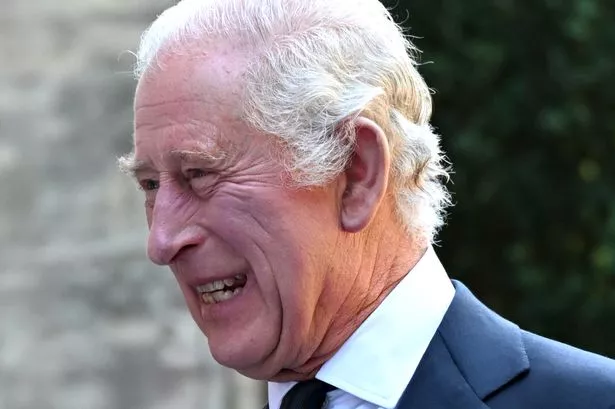King Charles has spent an increased amount of time at Windsor since his reign began (Image: Getty Images)Sign up to our free email to get all the latest royal news and picturesMore Newsletters SubscribePlease enter a valid emailSomething went wrong, please try again later.More NewslettersWe use your sign-up to provide content in ways you’ve consented to and improve our understanding of you. This may include adverts from us and third parties based on our knowledge of you. More infoThank you for subscribing!We have more newslettersShow me See OurPrivacy Notice See OurPrivacy Notice×Group 28 Sign up to our free email to get all the latest royal news and picturesInvalid emailSomething went wrong, please try again later.Sign UpNo thanks, closeWe use your sign-up to provide content in ways you’ve consented to and improve our understanding of you. This may include adverts from us and third parties based on our knowledge of you. More info×Group 28Thank you for subscribing!We have more newslettersShow MeNo thanks, closeSee our
Privacy NoticeQueen Elizabeth II always had a special connection with Windsor Estate, having spent her entire life there, from her childhood days at Royal Lodge to living in the grandeur of Windsor Castle. Even though he spends an increased amount of time there to see his young grandchildren, it has been reported that King Charles doesn’t share his mother’s love of the home and is said to find it “too noisy” due to its proximity to Heathrow Airport. Despite the late Queen’s long-standing presence at Windsor, she didn’t call every building on the vast estate home. Take Frogmore House, for example, this 16th-century retreat is steeped in royal history but never served as a residence for the monarch during her 70-year reign.
The late Queen and King Charles in the gardens of Frogmore House
(Image: Getty Images)
Read More
Related Articles
Prince Harry’s move sees him accused of losing ‘last shred of credibility’
Read More
Related Articles
Harry’s ‘sacrifice’ for Meghan laid bare – after he cuts ties with old friends
Situated a stone’s throw from Windsor Castle, Frogmore House was first the home of King Charles II’s illegitimate son, George FitzRoy, Duke of Northumberland. Over the years, it saw a variety of occupants until 1792 when it became a gift from King George III to his consort, Queen Charlotte. Named for the abundant frogs inhabiting its surrounding marshes, Frogmore House is not just known for this link but also houses the Royal Mausoleum, the final resting place of Queen Victoria and Prince Albert. The grand residence, filled with priceless art and antiques, is now a public attraction and allows visitors to marvel at its stunning interiors and beautiful gardens. However, the inside of the home remains a mystery as photography is strictly prohibited.
The beautiful Frogmore House on the Windsor estate
(Image: Getty Images/Robert Harding World Imagery)
Over the years, the residence has been the backdrop for significant royal events, including the wedding receptions of Peter Phillips and Autumn Kelly, and later, the Duke and Duchess of Sussex. Interestingly, another royal residence where the late monarch never resided during her many years in Windsor played a pivotal role in shaping her life. Fort Belvedere, a Royal home built between 1750 and 1755 for Prince William Augustus, is nestled in Windsor Great Park. Designed in the Gothic Revival architectural style, the home was affectionately known as ‘The Fort’ by many Royal Family members.
Queen Elizabeth lived on the Windsor Estate her whole life
(Image: PA)
King George IV significantly expanded the home, adding an octagonal dining room, a three-storey annex, and a large flag pole. Later, Queen Victoria used the fort as a tea house and opened it to the public in the 1860s. The fort, which had been largely unoccupied for many years, found its most famous resident in 1929. Prince Edward, the Prince of Wales (who would later become King Edward VIII and The Duke of Windsor), moved into the home and gave it a £21,000 (£1.49 million today) makeover.
King Edward VIII signed his abdication papers at Fort Belvedere
(Image: High Level/REX/Shutterstock)
Fort Belvedere also served as the setting for his notorious love affair with Mrs Wallis Simpson, who moved in permanently in 1936. When Prince Edward ascended to the throne in January 1936, he was confronted with the harsh reality that he couldn’t be king and marry Wallis Simpson, a twice-divorced American. The King declared his intention to abdicate, paving the way for his brother to become King George VI and making the then Princess Elizabeth the heir apparent. He held several meetings with Prime Minister Stanley Baldwin during this crisis, eventually signing his written abdication notices at the fort. After Edward vacated the property, it remained empty until 1955 when the Queen’s cousin Gerald Lascelles moved in. The home changed hands again in 1976 and was leased to Canadian billionaire Galen Weston.Story SavedYou can find this story in My Bookmarks.Or by navigating to the user icon in the top right.Follow OK! MagazineFacebookTwitterCommentMore OnKate MiddletonPrince WilliamRoyal FamilyWindsor CastleDuke of WindsorWindsorQueen Elizabeth IIKing Charles IIIFrogmore












